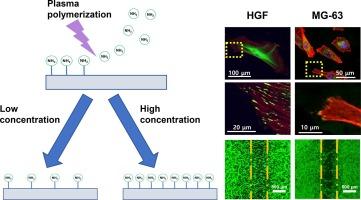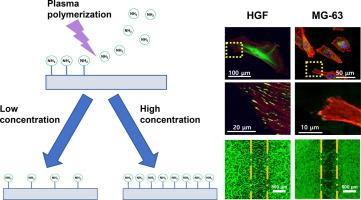CPA等离子体聚合制备的牙龈成纤维细胞和人骨肉瘤细胞在胺梯度表面的行为
IF 6.9
2区 材料科学
Q2 CHEMISTRY, PHYSICAL
引用次数: 0
摘要
牙周病经常影响口腔组织,导致永久性牙齿脱落和骨骼缺损。口腔组织的再生主要依赖于生物材料表面的表面形态和化学性质。等离子体技术是一种安全有效的制造具有合适表面特性的生物材料的工具。我们研究了人牙龈成纤维细胞(HGF-1)和人骨肉瘤细胞(MG-63)在胺梯度表面用环丙胺(CPA)聚合制备的行为。采用接触角、zeta电位、AFM、FTIR和XPS分析了CPA薄膜的表面特性。根据细胞粘附、迁移和增殖来评估细胞行为。等离子体聚合后,通过FTIR和XPS证实了原始PLGA膜表面被修饰成胺功能化表面。此外,胺官能团是亲水的。这改善了口腔组织细胞的初始附着或增殖。此外,证实了聚合物表面胺梯度的最佳浓度取决于组成组织的特定细胞类型。这些结果表明,等离子体聚合在聚合物表面形成的胺表面为口腔组织细胞的再生提供了良好的环境。本文章由计算机程序翻译,如有差异,请以英文原文为准。


Behavior of human gingival fibroblasts and human osteosarcoma cells on amine-gradient surfaces prepared by CPA plasma-polymerization
Periodontal disease frequently affects oral tissue and induces permanent loss of teeth and defects in the bone. The regeneration of oral tissue primarily relies on the surface morphology and chemical properties of biomaterial surfaces. Plasma technology is a safe and efficient tool for creating biomaterials with suitable surface properties. We investigated the behavior of human gingival fibroblasts (HGF-1) and human osteosarcoma cells (MG-63) on an amine-gradient surface prepared using cyclopropylamine (CPA) polymerization. The surface characteristics of the CPA thin film were analyzed using contact angle, zeta potential, AFM, FTIR, and XPS. The cell behavior was evaluated based on cell adhesion, migration, and proliferation. After CPA plasma-polymerization, it was confirmed that the pristine poly (lactide-co-glycolide) (PLGA) film surface had been modified into an amine-functionalized surface by FTIR and XPS. In addition, amine functional groups are hydrophilic. This improved the initial attachment or proliferation of oral tissue cells. Furthermore, it was confirmed that the optimal concentration of the amine gradient on the polymer surface varies depending on the specific cell types comprising the tissue. These results indicated that amine surfaces formed by plasma-polymerization on polymer surfaces provide an excellent environment for the regeneration of oral tissue cells.
求助全文
通过发布文献求助,成功后即可免费获取论文全文。
去求助
来源期刊

Applied Surface Science
工程技术-材料科学:膜
CiteScore
12.50
自引率
7.50%
发文量
3393
审稿时长
67 days
期刊介绍:
Applied Surface Science covers topics contributing to a better understanding of surfaces, interfaces, nanostructures and their applications. The journal is concerned with scientific research on the atomic and molecular level of material properties determined with specific surface analytical techniques and/or computational methods, as well as the processing of such structures.
 求助内容:
求助内容: 应助结果提醒方式:
应助结果提醒方式:


